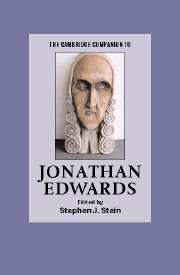Book contents
- Frontmatter
- Introduction
- Part I Edwards’s life and context
- Part II Edwards’s roles and achievements
- Part III Edwards’s legacy and reputation
- 11 Evangelical tradition in America
- 12 The reputation of Edwards abroad
- 13 Edwards and American literature
- 14 Edwards in “American culture”
- 15 Edwards’s intellectual legacy
- 16 Edwards and social issues
- The Works of Jonathan Edwards
- Further Readings
- Index
- Series List
14 - Edwards in “American culture”
from Part III - Edwards’s legacy and reputation
Published online by Cambridge University Press: 28 November 2007
- Frontmatter
- Introduction
- Part I Edwards’s life and context
- Part II Edwards’s roles and achievements
- Part III Edwards’s legacy and reputation
- 11 Evangelical tradition in America
- 12 The reputation of Edwards abroad
- 13 Edwards and American literature
- 14 Edwards in “American culture”
- 15 Edwards’s intellectual legacy
- 16 Edwards and social issues
- The Works of Jonathan Edwards
- Further Readings
- Index
- Series List
Summary
In 1858, a hundred years after Jonathan Edwards died, “The Deacon's Masterpiece: or The Wonderful 'One-Hoss-Shay.' A Logical Story ” appeared in The Atlantic Monthly.
Have you heard of the wonderful one-hoss-shay, That was built in such a logical way It ran a hundred years to the day, And then, of a sudden, it - ah, but stay, I'll tell you what happened without delay, Scaring the parson into fits, Frightening people out of their wits, Have you ever heard of that, I say?
Other than that perfect bit of timing, both the date of construction of the chaise - ”Seventeen hundred and fifty-five ” - and the measure of its history hint at Edwards and Freedom of the Will, first published in 1754. More directly, if less rhythmically, Oliver Wendell Holmes later castigates Edwards in more than two dozen pages of the International Review, declaring his theology a “barbaric, mechanical, materialistic, pessimistic ” system. And, returning to a fictive account at about the same time, Holmes identifies the “real aim ” of his novel Elsie Venner, A Romance of Destiny, as a “test ” of original sin and “human responsibility for the disordered volition. ” That the poem found its way onto the pages of The Atlantic during its first year may be little more than public notice for one of its founders, much like the lines of Emerson, Longfellow, and Lowell, its first editor. Yet its publication proved significant for Edwards, not so much in its form as its forum, “a magazine, ” as the cover leaf of The Atlantic had it, “of literature, art, and politics. ”
- Type
- Chapter
- Information
- The Cambridge Companion to Jonathan Edwards , pp. 280 - 299Publisher: Cambridge University PressPrint publication year: 2006



